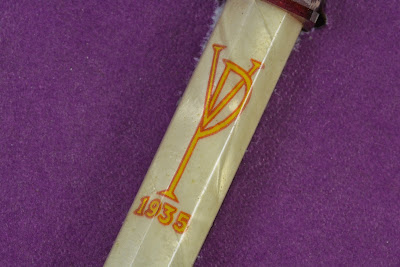This article has been edited and included in The Leadhead's Pencil Blog Volume 5; copies are available print on demand through Amazon here, and I offer an ebook version in pdf format at the Legendary Lead Company here.
If you don't want the book but you enjoy this article, please consider supporting the Blog project here.
The box, with a “VP” logo and the year 1935, opens to reveal four matching pencils:
Each also bearing that same VP logo:
The presentation of these pencils far exceeds the quality of the pencils themselves, which are ordinary nose-drive pencils with exposed erasers . . . although the faceted top piece to prevent them from rolling around is kind of neat.
My real focus was that logo and what it meant. I’ve seen these a few times before - Bruce Mindrup has had one on his table, and they turn up at flea markets from time to time.
I paid for the box and was just walking away from that table when George Rimakis flagged me down - he and his father John were wandering around, and George had some things he wanted to show me. We sat down at a nearby vacant table and, while George was unpacking his backpack in preparation for the big reveal, I showed him and his dad my recently acquired boxed set.
Then George showed me what he had in tow, and I was so overwhelmed I forgot all about the mysterious VP and what it meant. After George and I were finished, though, his John came over with his cell phone in hand, browser up. “Veiled Prophet,” he said.
At first it didn’t register what he was saying to me, so distracted I was by what George had just shown me. “Your pencil set,” John said. “The logo stands for ‘Veiled Prophet.’”
Back to earth I came, and he was right. The Veiled Prophet is a quasi-fraternal, quasi-social organization founded in St. Louis in 1878, which to this day puts on an annual parade, known as “Fair St. Louis” these days. It is difficult in today’s climate to know what is true about the Veiled Prophet, and I don’t know whether social justice warriors have been revising the history of the organization or revealing it.
The Veiled Profit Organization is attributed to Charles Slayback, and anti-Prophet sources say only that he is “a former Confederate Cavalryman,” as if 13 years after the end of the Civil War, Slayback still had done nothing else with his life. That obviously isn’t true, since Slayback must have been a prominent member of St. Louis society to bring together the city’s rich and powerful, putting together a country-club sort of group to put on an annual parade and pageant.
Also true is that there was a massive railroad strike in 1877 in the area, and the organization of the Veiled Prophet to put on a spectacular parade is seen by some as an effort by the economically powerful to assert their dominance over the working class, and by others as an attempt by the upper crust of St. Louis to put on a nice event in an effort to put the ugly past behind them.
Sources committed to proving racism exists everywhere point to the fact that the Veiled Prophet organization was not racially diverse for the first century of its existence (not admitting its first African American member until the 1970s), although even one of the more slanted accounts I read conceded that since the criteria for membership was economic, racial exclusion of minorities in nineteenth-century St. Louis may have been less intentional than incidental.
Several sources also compare the appearance of the Veiled Prophet’s costume to that of a member in the Ku Klux Klan (the Veiled Prophet in garb is the grand marshal of the parade as well as the annual Veiled Prophet ball, which crowns one debutante in attendance as the “Queen of Love and Beauty”). However, I find no source indicating that the Veiled Prophet was ever involved in violence or other forms of organized racial oppression.
As Missouri continues to bleed and America continues to tear itself apart, I can choose to see the bad or the good in anything, and I choose to see the good. I choose to see an annual event which involves people coming together in peaceful celebration. I am not ignoring any dark side to this organization, because I see no evidence of a darker motivation – only the opinions of those who choose to see them.
If these pencils bore KKK emblems, they would have no place in my home, since hatred and racism are contrary to the Constitution and to my beliefs. They do not. They commemorate the activities of people who, by today’s standards in certain circles, were damned no matter what they did solely because of the color of their skin.
And that, whether America chooses to admit it or not, is racism.
Now to get off my soap box and get back to pencils . . . as for that spectacular stuff George showed me, I’ll get to that. The day after tomorrow . . .



1 comment:
Post a Comment